The symbolism of cut hair in Iranian protest posters
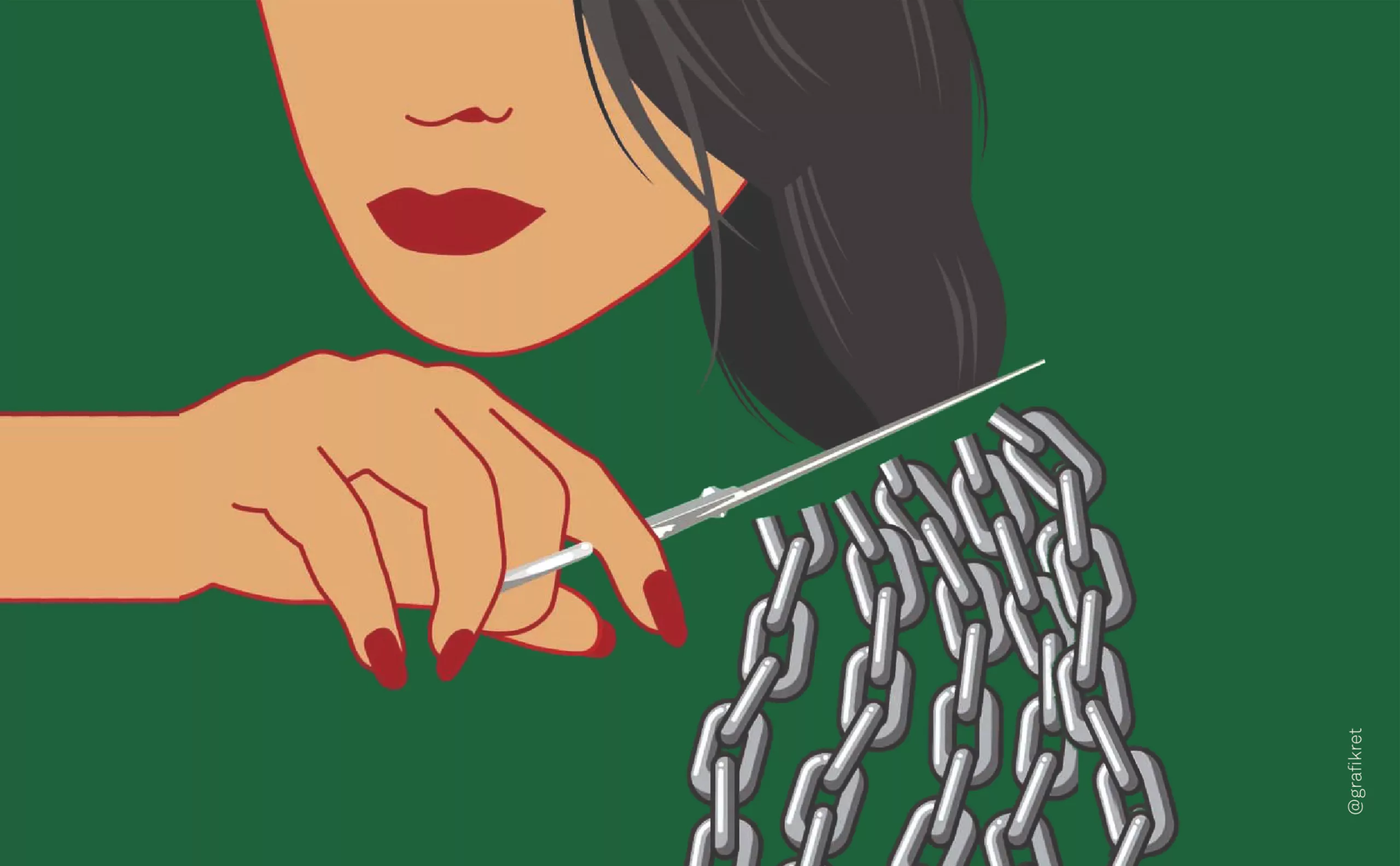
Iran, September 2022. Mahsa Amini, a 22-year-old Iranian Kurdish woman, is arrested by the morality and “moral conduct” police of President Raissi’s regime. Since July 2022, a law “on the wearing of the hijab and the chastity of the country” has imposed new restrictions on women: the compulsory headscarf must now cover the neck and shoulders, in addition to the hair.
Mahsa died for a lock of hair not properly hidden behind a scarf.
This was the fuse that ignited the massive protest movement of thousands of Iranians against the mullahs’ regime.
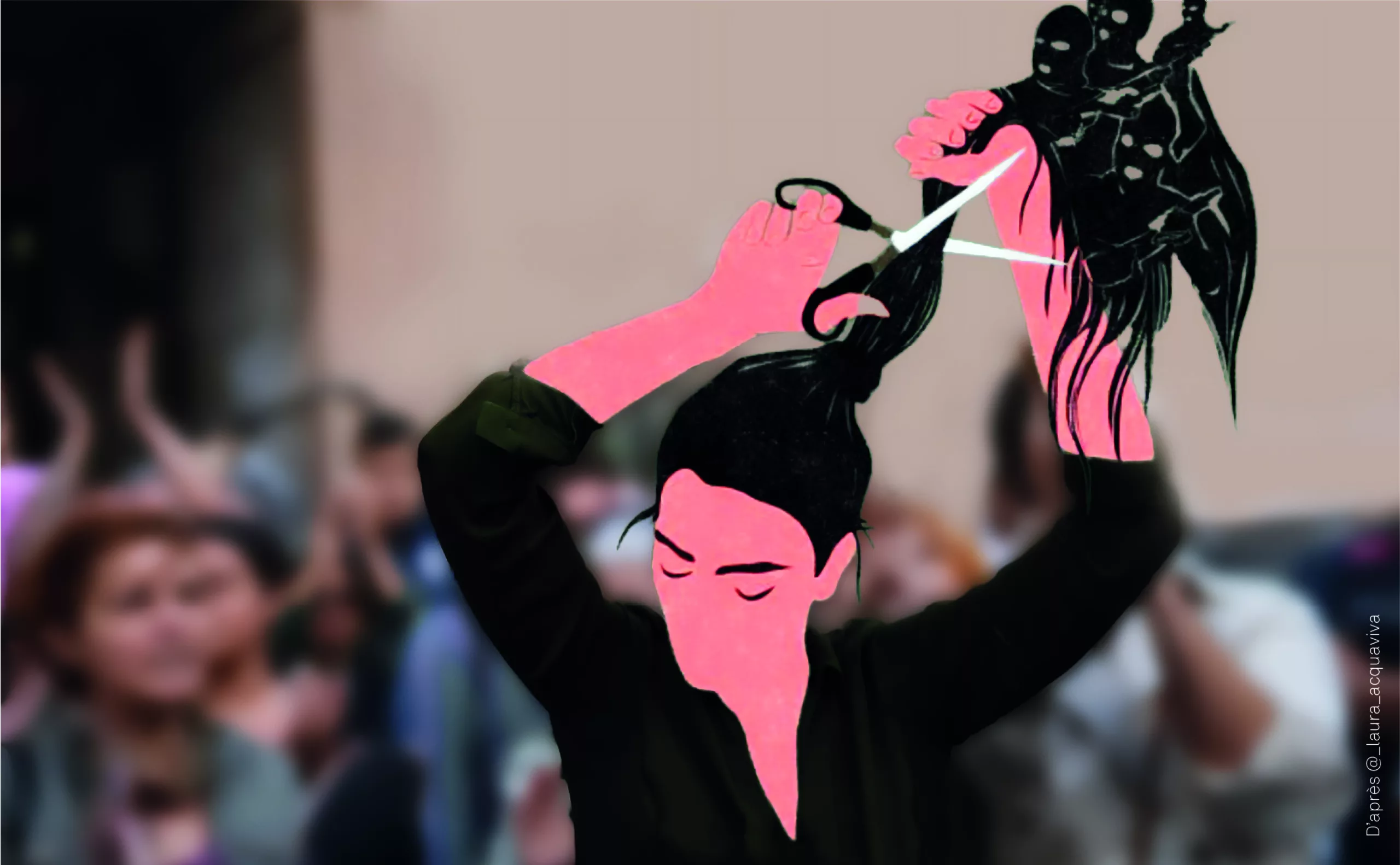
As in any revolt, many visuals have appeared on the networks, taking over the iconography of the demonstrations. These posters by Iranian and international designers conjure up symbolic elements that resound in unison: figures of women who stand up, strong and proud, determined and united, their hair loose or mutilated, like fleeces emblematic of this struggle for their freedom.
The symbolic gesture of the demonstrators cutting their hair is one of the recurring motifs in these images. In addition to supporting this mobilisation and relaying the work of our fellow designers, we wanted to question the evolution and strength of the symbolism of hair over time and across cultures.
A questioning, which we hope will not make your hair hurt too much!
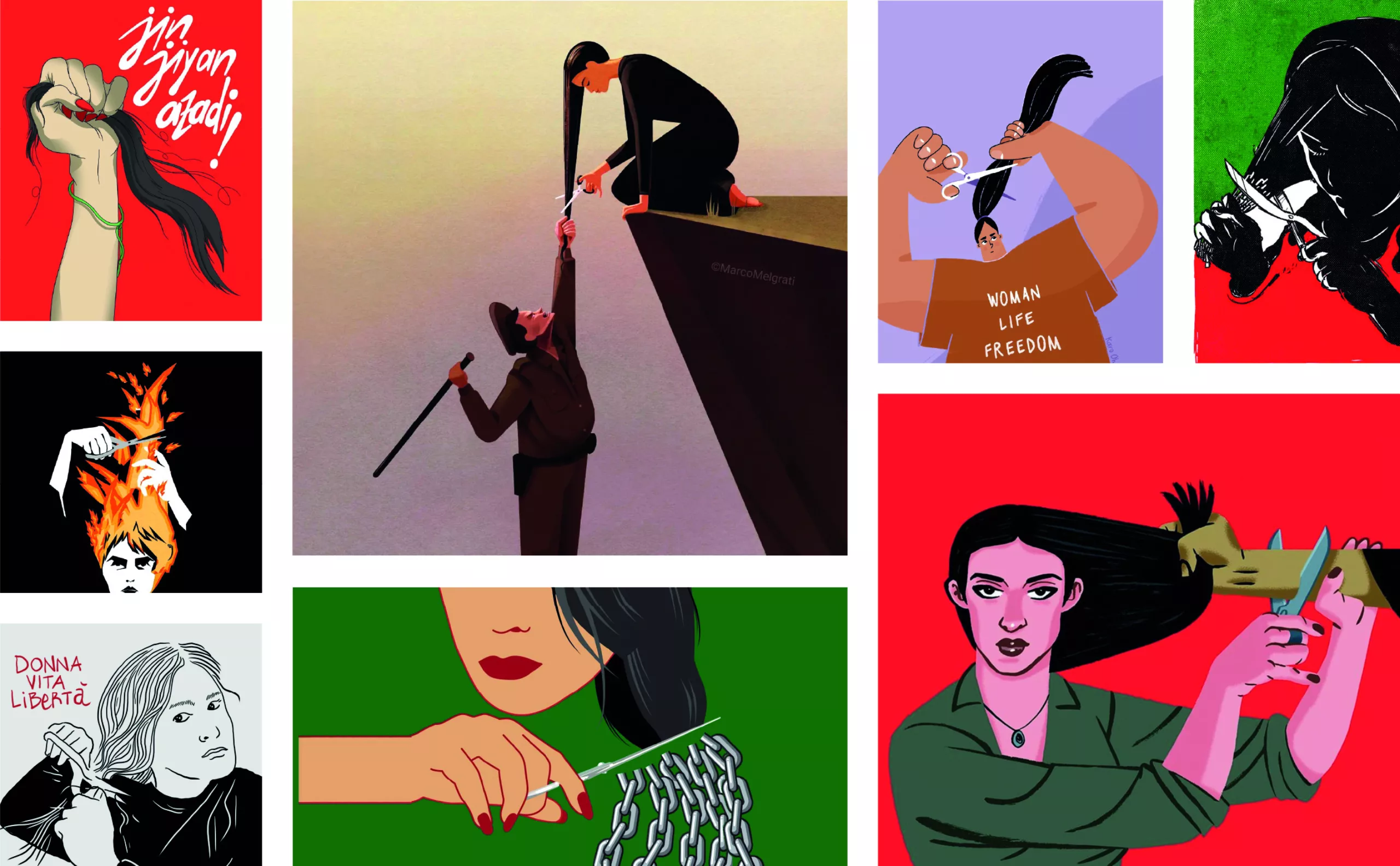
The significance and symbolic charge of hair over time
Let’s start with a little linguistic detour. Hair expressions are a dime a dozen. They can be used to illustrate exasperation (« tear your hair out »), fear (« make your hair stand on end »), a tenuous distance (« by a hair’s breadth »), when you bother someone (« get in someone’s hair »), relaxation (« let your hair down »), when someone looks perfect (« not/never a hair out of place »), or an excess of subtlety (« split hair »).
Since ancient times, poets have praised long female hair for its erotic power. Long hair was not only considered an attribute of beauty, but above all a symbol of femininity.
Paradoxically, for men, long hair was the foundation of power and their virile power . In those days, those who wore their hair short were the social classes considered inferior, and it was imposed on them. It’s worth noting that all slaves were shaved.
In Gaul, hair had to be long to symbolize freedom.
Subsequently, codes evolved. Art history shows that, until the end of the 19th century, a tied-back hairstyle was almost always the rule in painting; loose hair, for example, belonged to the realm of intimacy.
Hair thus provides clues as to a character’s identity, period and social class.
The 20s saw the advent of the aptly named “garçonne” (boyish) haircut. As with pants, the appropriation of this cut, then associated with masculinity – is it still? – by women caused a scandal. Symbolizing the Roaring Twenties and the profound desire for women’s emancipation that swept from Europe to the United States, the eton crop is a radically shorter version, whose muse is Josephine Baker.
In short, depending on the era, a man who wore his hair long was powerful, while a woman who sported a short haircut was boisterously scandalous.
In his monograph on rites of passage, ethnologist Arnold Van Gennep focuses on the cutting and offering of hair. He sees the cutting of hair as a ritual of separation from the previous world. According to him, covering one’s hair with a veil expresses the act of separating oneself from one world to join another.
In ancient Greece, young women’s loose hair was a sign that they were not yet subject to marital union. Conversely, once married, their hair was meticulously combed and veiled. A symbol of yoking, this ritualized and culturally-organized domestication was intended to subject them to patriarchal power through marriage.
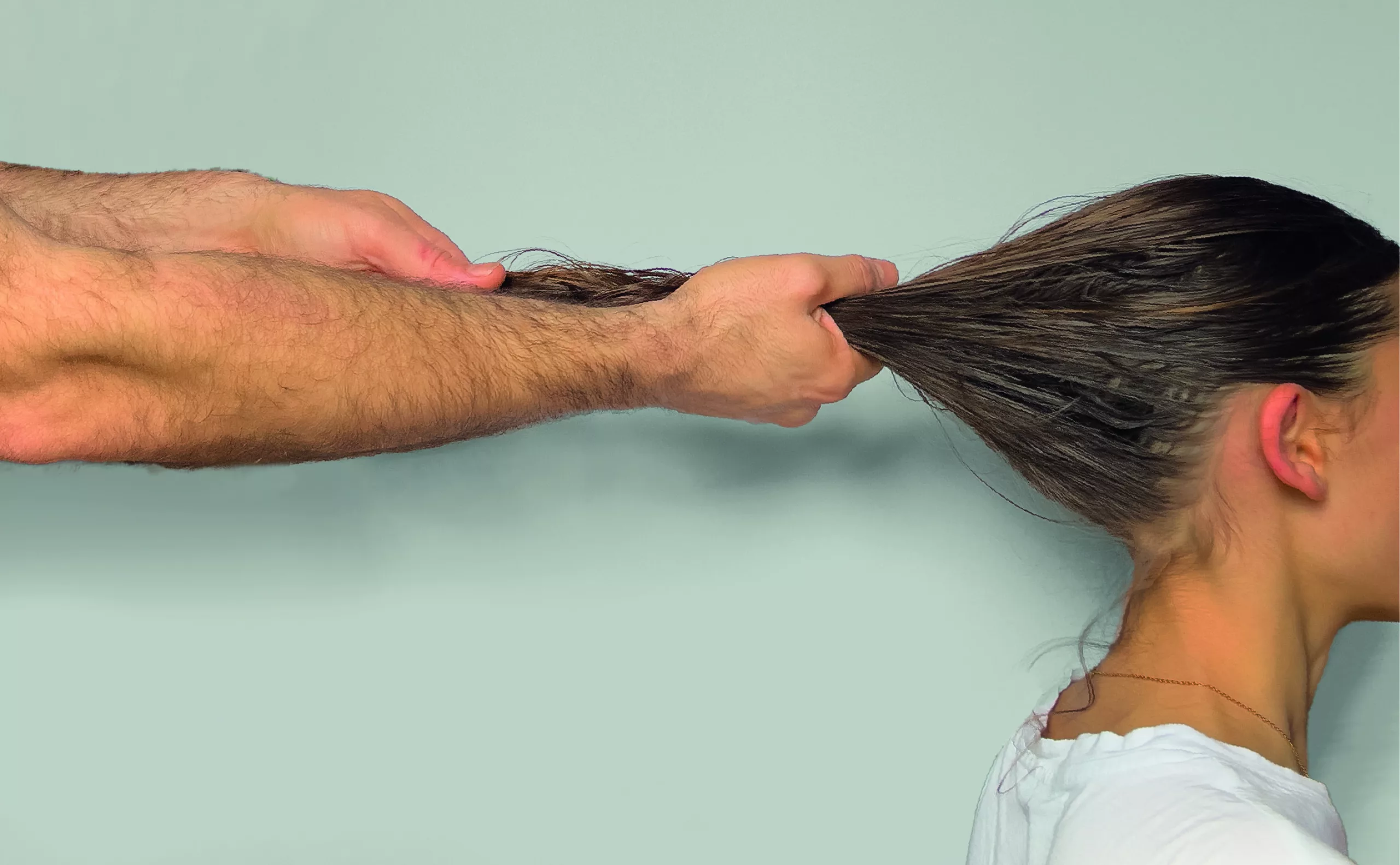
In contrast to the wisely concealed hair of brides, the hair of the bereaved, which could be seen and pulled out – as in the case of mourners – embodied a threat that had to be contained by imposing limits on this ritual expression of feminine pain. The untied hair of courtesans, on the other hand, reflected their sexual freedom, in total breach of the rules of modesty and concealment of the body, which were supposed to define the respectable and virtuous woman.
In this way, ancient Greek capillary practices conveyed latent codes and systems of representation. Greece was no exception in this respect, and certain historical texts attest to the invariance of the relationship of humanity that mankind has always maintained with hair.
The dark days of the Second World War were the scene of capillary punishments, with concentration camp deportees being shorn on the pretext of hygiene, according to their captors. An extreme gesture of reification – the action of transforming into a thing – hair was recovered and industrially transformed by the Nazis. In the same dehumanizing dimension, after the Liberation in France, more than 20,000 women suspected of having had relations with the occupying forces were also subjected to the humiliating punishment of being shorn in public.
Today, shaved hair can also refer to the effects of chemotherapy treatments, and therefore to illness.
Some iconic hairstyles
From a mythological point of view, the image that first springs to mind is that of Samson and his hair – like Achilles and his heel.
Samson, symbol of virile power, defeated by the feminine perfidy of his beloved Delilah, who, in exchange for money, made him confess the secret of his strength and cut off the seven braids of his hair, a symbol of his magical power.
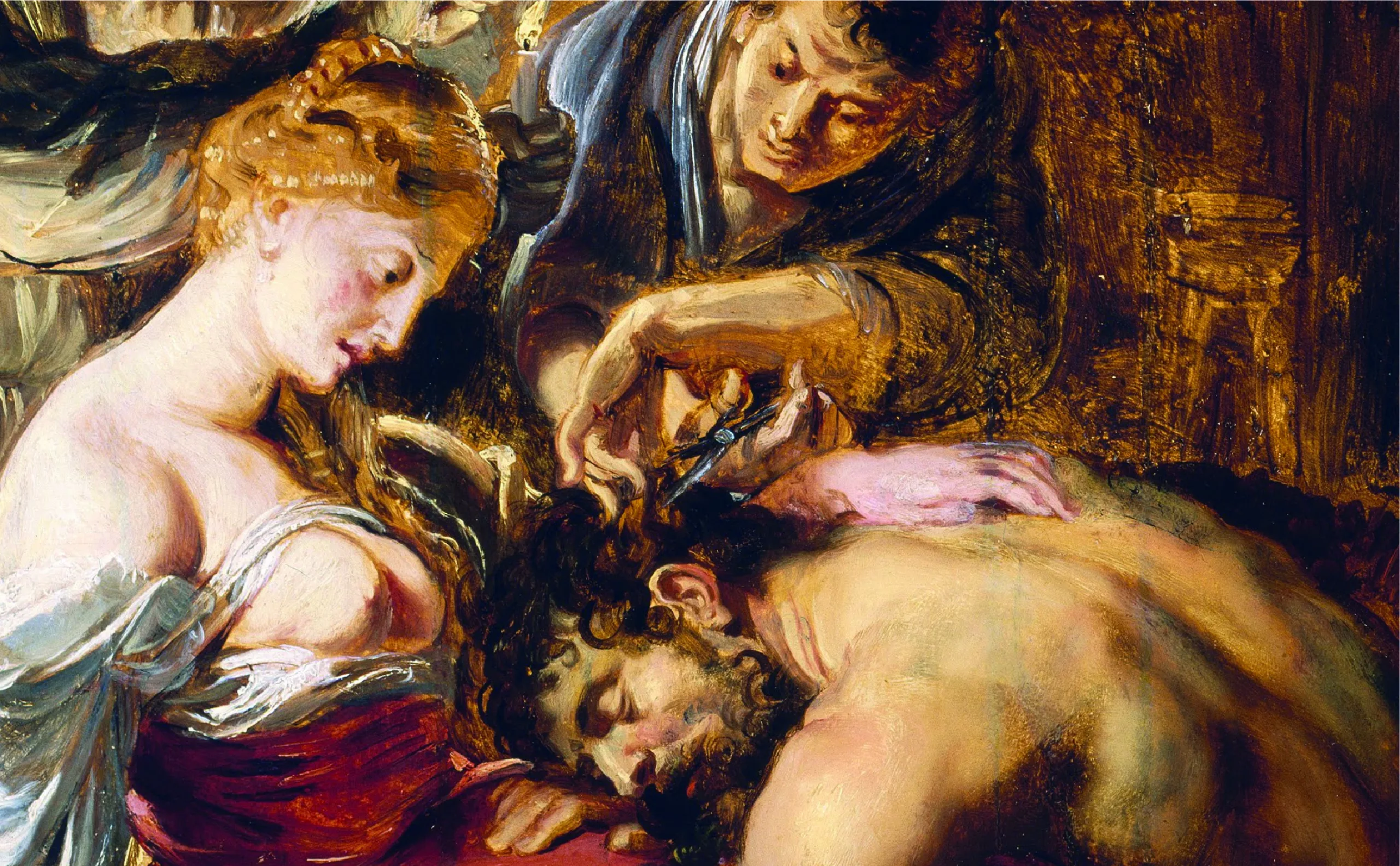
Rapunzel is a princess with magnificent golden hair, from a tale by the Brothers Grimm, which was also adapted into a cartoon by Walt Disney.
One night, when she’s just been born, an evil witch enters the castle to cut off a lock of her hair, which has been given magical powers. However, as soon as the hair is cut, it loses its powers and its golden light. The child is kidnapped and locked away in a tower deep in the forest. The princess’s long hair is the only way to access the tower’s only window, allowing the witch to retain her youth. However, it will also be the means of her liberating escape.
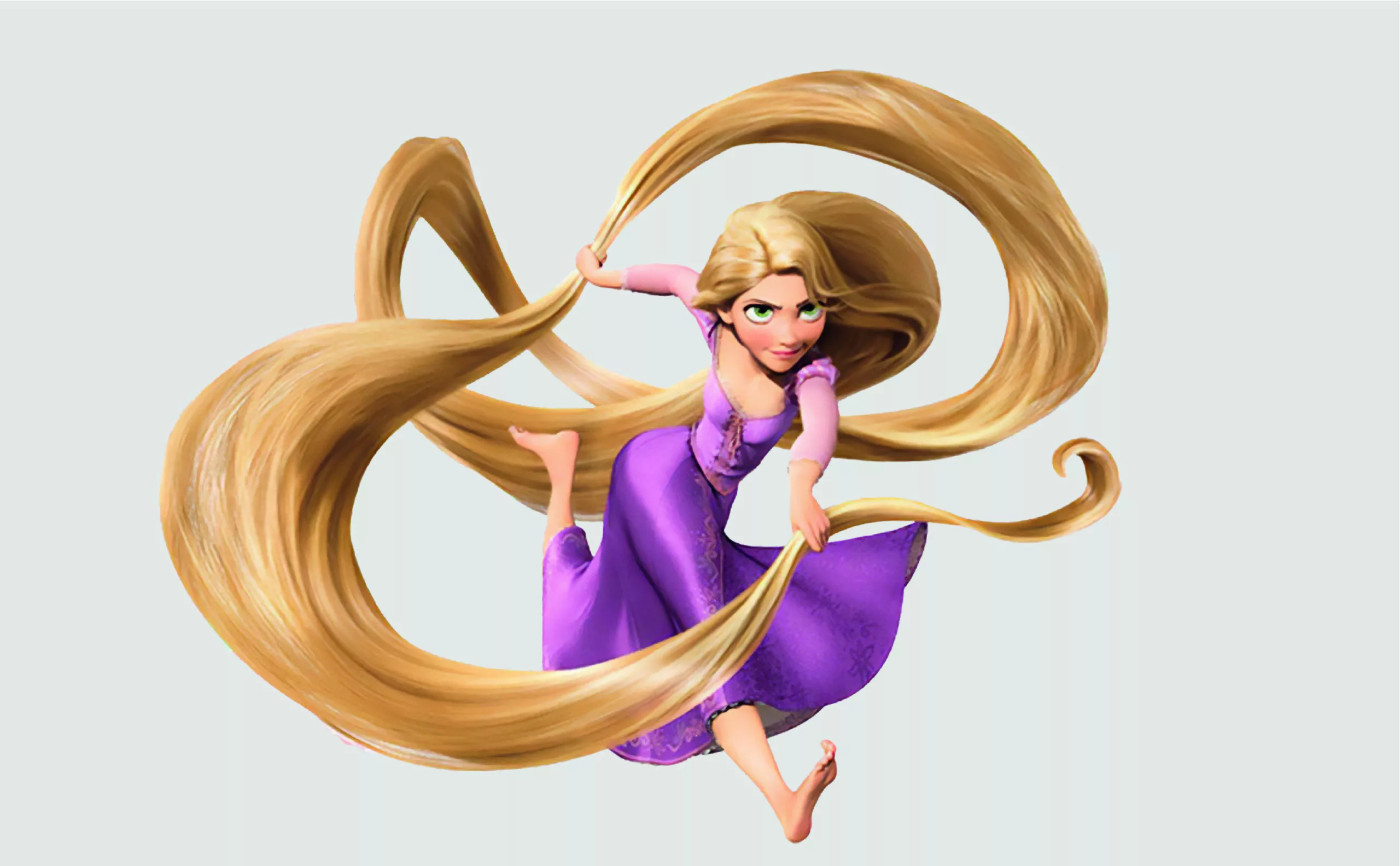
Medusa is one of the Gorgon sisters in Greek mythology. A monstrous figure with tentacular hair and wriggling, venomous snakes, she turns to stone anyone unfortunate enough to meet her gaze.
Yet it wasn’t always so: Ovid mentions that “of all her attractions, what most charmed the eye was her hair”. But Medusa, who dared to defy the goddess Athena, was punished for her pride and her hair turned into a reptile.
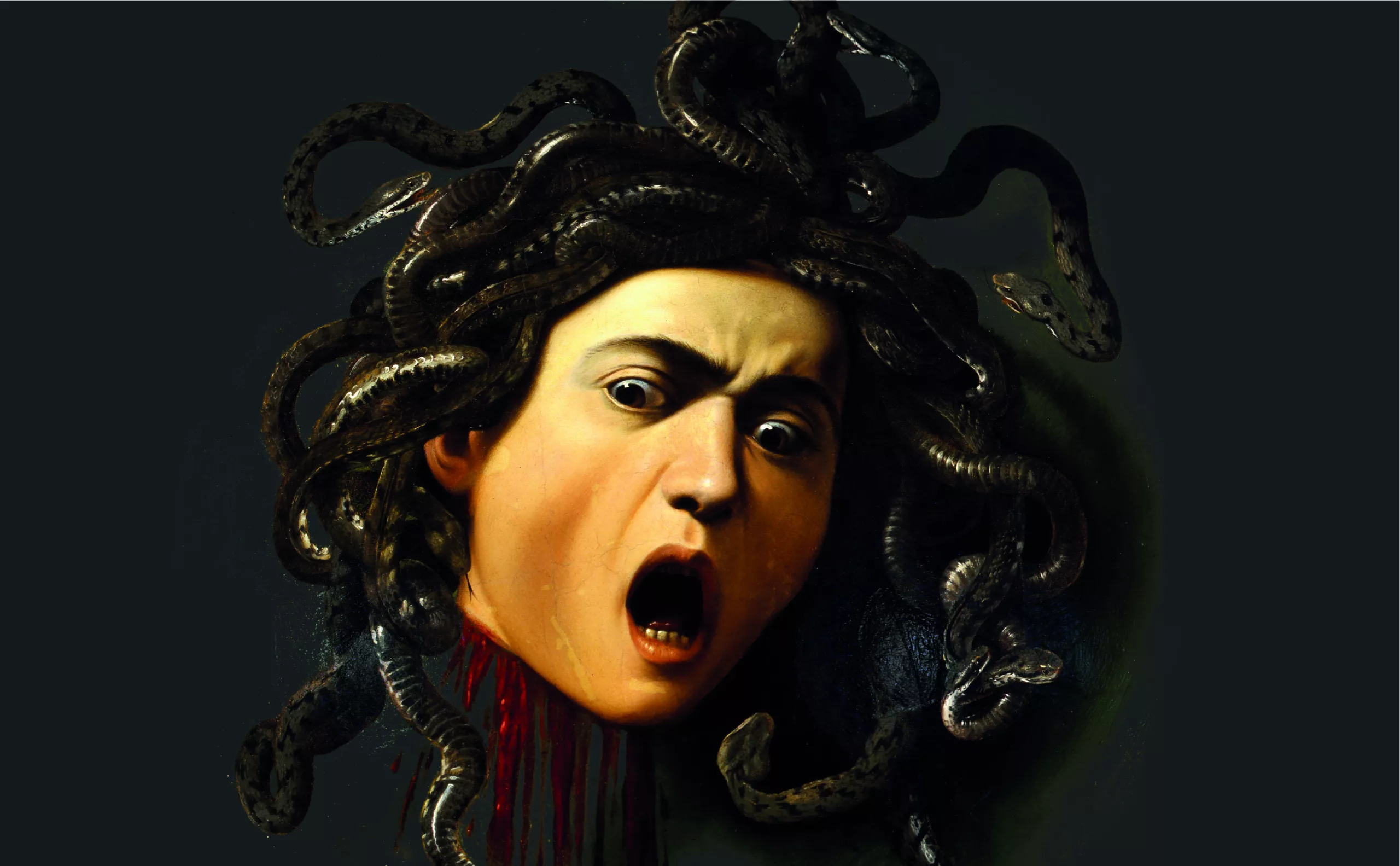
Joan of Arc, who raised an army against the English enemy, broke away from the hair conventions of her time and chose to cut her hair “bowl”, like a knight. This hairstyle was to be blamed on the heretic during her trial. Before being burned, she was shaved.

From Samson to Mahsa Amini, by semiological capillarity
Since the death of Mahsa Amini in Iran in September 2022, and as Iranian high-school girls are targeted by gas poisoning aimed at dissuading them from going to school, the slogan “Zan, zendegi, azadi” – “woman, life, freedom” – has echoed around the world like an echo that is now impossible not to hear.
To mark International Women’s Rights Day, and in solidarity with the protest movement shaking Iran, the Musée d’Art Moderne of Paris, the Palais de Tokyo, the École des Beaux-Arts, the Palais de la Porte-Dorée and other museums in France, including the Musée d’Art Contemporain de Lyon, will be adorning their pediments throughout March with posters featuring a long cut hair. This symbolizes freedom, in direct opposition to the wearing of the veil – the forced imposition of which in Iran dates back to 1979.
The myth of Samson having his power taken away by cutting off his hair has been replaced by the image of this hair floating in the wind, like a banner of freedom.
If loose hair symbolizes freedom – defying the obligation to wear the veil and the secular yoke – then what does it mean to cut it off like chains?

This symbolic gesture mobilizes not only the rebels, but women all over the world, who cut off locks of hair or even shave their heads. So it seems important to try and unravel the meaning of this act.
In Kurdistan and Lorestan, women cut their hair as a sign of mourning. According to Iranian sociologist Chahla Chafiq, the gesture of women demonstrators with mutilated hair is an expression of collective mourning.
While the expression of this mourning in no way detracts from its political protest dimension, the gesture becomes a symbol of a growing anger, rumbling and rising up against the mullahs’ regime’s denial of fundamental freedoms.
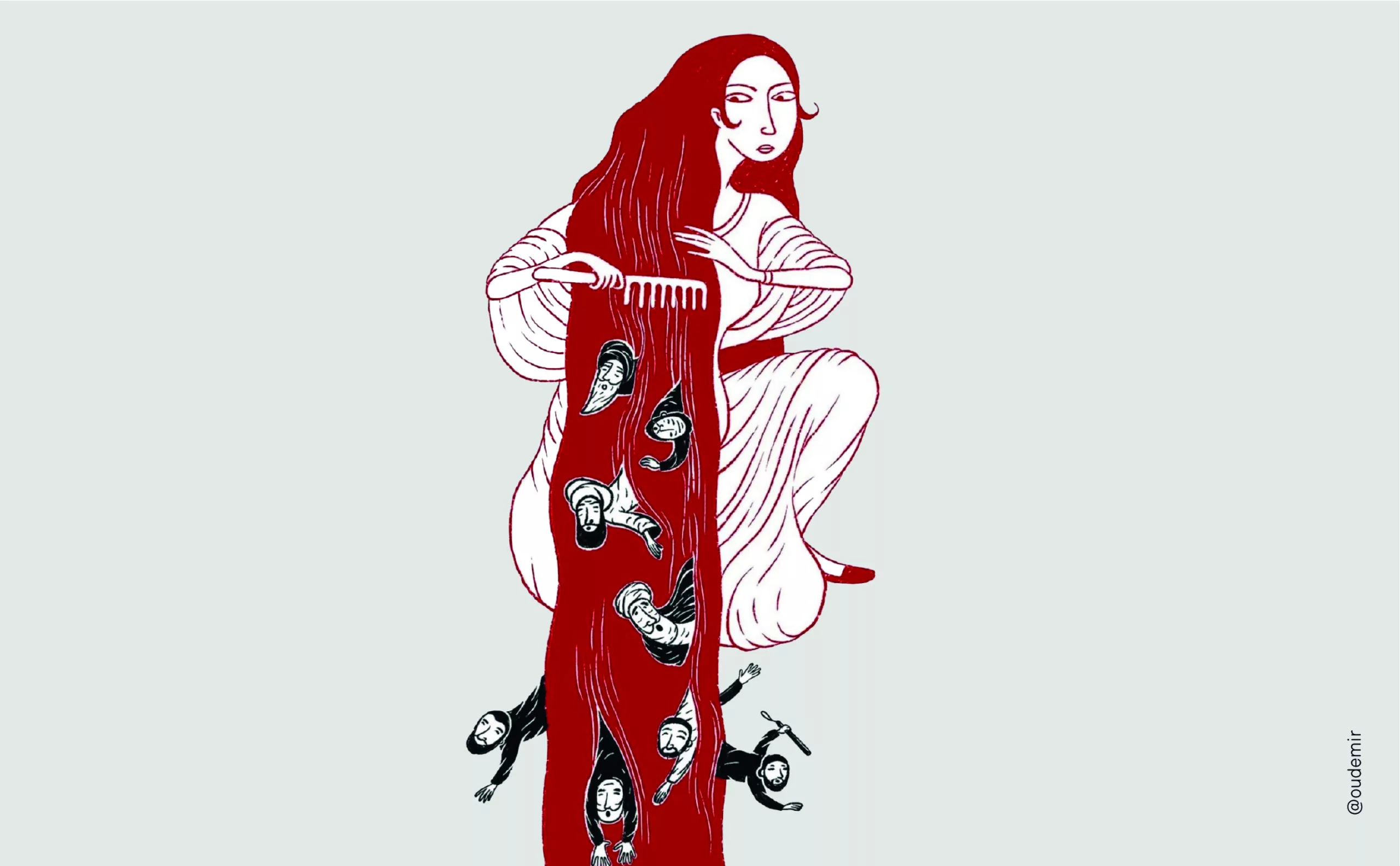
If social movements can generate, in the spontaneity of action and protest, signs as unexpected as these, they are in fact a privileged theater for the production of meaning.
For example, since Mahsa’s death, the protest visuals that have appeared on the networks, taking over the iconography of demonstrations, have generated numerous solidarity actions around the world. Common signs that resound in unison, including this eminently symbolic gesture of hair mutilation, become standard-bearers of this legitimately claimed freedom.
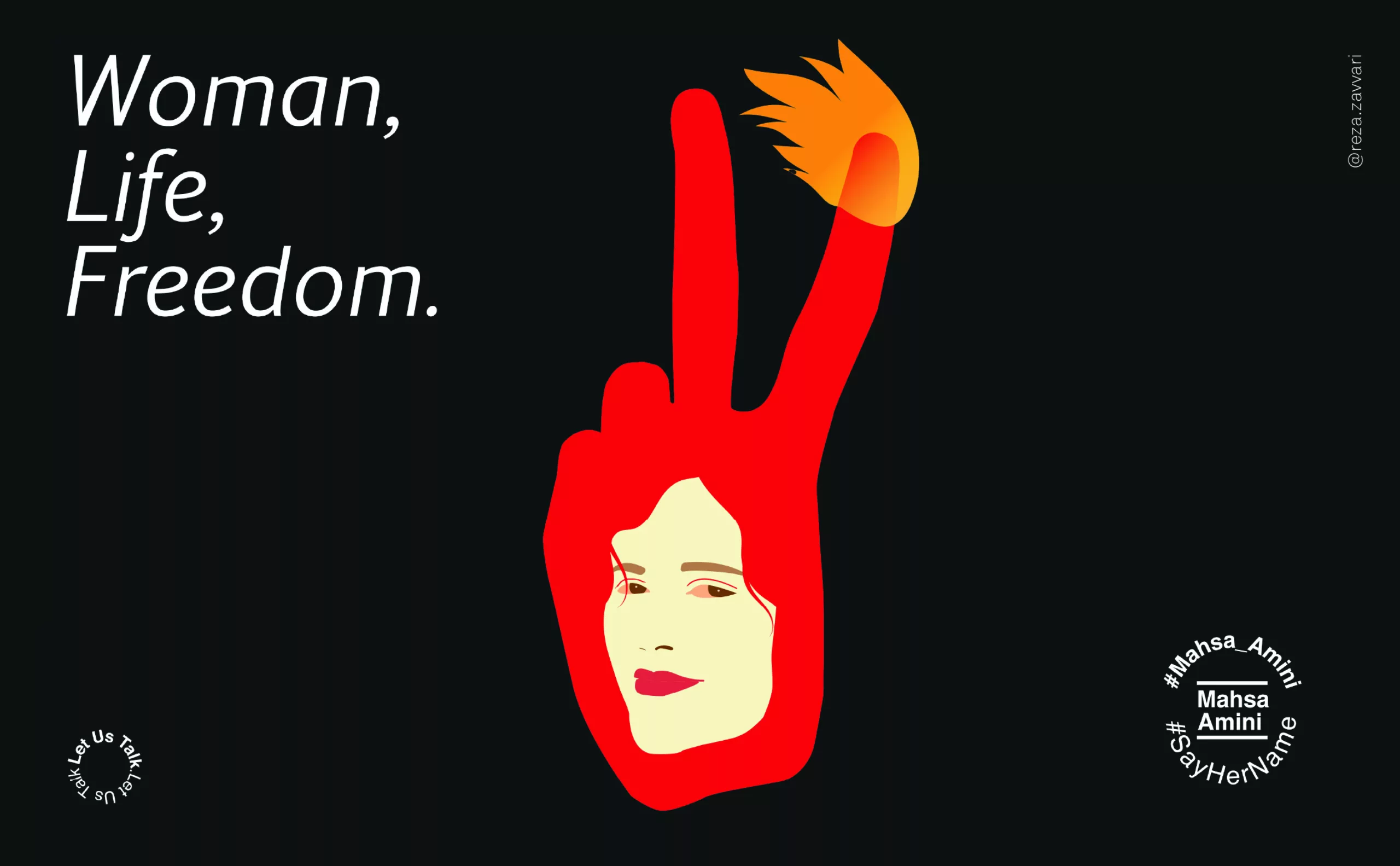
On the Instagram account of the Iranian Women of Graphic Design collective, which highlights the work of Iranian female graphic designers, those working in the fields of design, typography, motion design, illustration and, more broadly, the visual arts are also invited to submit their creations – or publish them directly, using the hashtag #WomanLifeFreedom.
It’s worth noting that Iran has a long and rich history in graphic design, as we recalled in our article on the genius of Iranian graphic design.
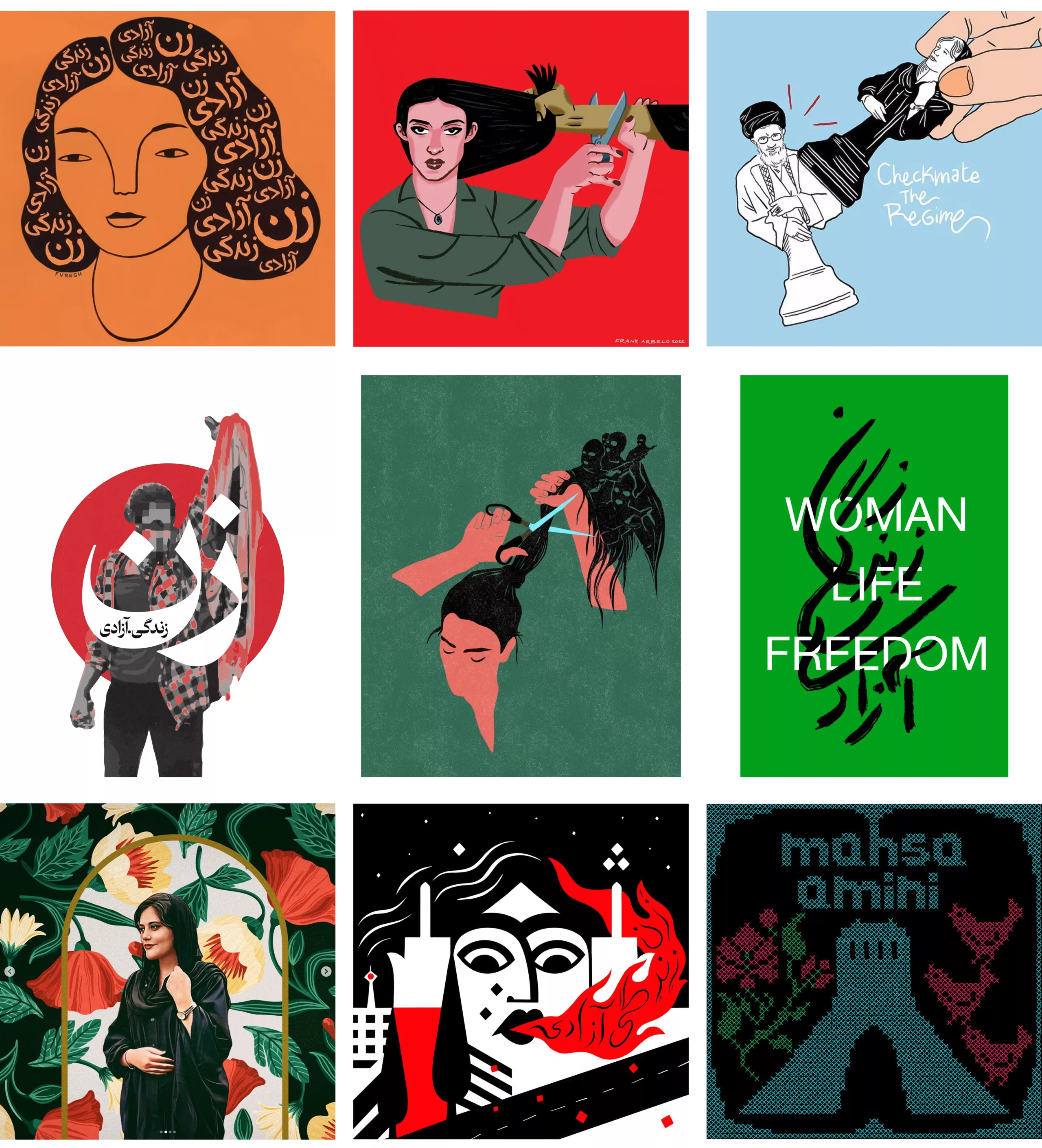
This article was written by Emmanuelle Valli, a lecturer in Information and Communication Sciences and Semiology. We thank her for her collaboration !
Sources :
- reainfo.hypotheses.org/16085
- www.lemonde.fr/la-chevelure-et-ses-symboles.html
- theses.hal.science/tel-01838283/document
- www.lemonde.fr/une-myriade-d-affiches-en-soutien-a-la-contestation-en-iran-exposee-a-paris.html
- www.lemonde.fr/iran-se-couper-des-meches-de-cheveux-un-geste-symbolique.html
- www.radiofrance.frcouvrir-raser-exhiber-la-chevelure-feminine-en-bataille-politique-1739608
- www.ict-toulouse.fr/wp-content/uploads/2021/01/Inter-Lignes-n23.pdf
- « Plutôt morts que scalpés », Yves Matagon


